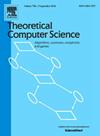Target influence maximization problem under avoiding unexpected users interruption in online social network
IF 1
4区 计算机科学
Q3 COMPUTER SCIENCE, THEORY & METHODS
引用次数: 0
Abstract
The effectiveness of viral marketing lies in the fact that it can activate a “chain-reaction” driven by word-of-mouth. This paper defines unexpected users’ interruption as the unintentional activation of impedimental users who disseminate negative evaluations. Such interruptions may arise during the process of selecting seed nodes intended to maximize influence spread among target users and foster brand awareness. Furthermore, it is typical to tailor promotions for specific user groups. For instance, consider an event organizer who shares an event advertisement on a social platform, aiming to capture the interest of a large local audience. To solve this problem, we devise positive and target influence maximization under the impedimental influence problem (PTIM), aiming to initiate from a set of influential seed users such that eventually, they will trigger the largest positive influence spread among target users. We prove that the objective function is neither submodular nor supermodular. Then, we decompose it into the difference between two submodular functions (DS decomposition). To solve the maximization problem of DS decomposition under cardinality constraint, we provide an explicit DS greedy algorithm with approximation guarantee. Finally, the experimental simulations on three network data sets demonstrate the effectiveness of our method.
在线社交网络中避免用户意外中断的目标影响最大化问题
病毒式营销的有效性在于它可以激活由口碑驱动的“连锁反应”。本文将意外用户中断定义为传播负面评价的障碍用户的无意激活。这种中断可能出现在选择种子节点的过程中,目的是最大化影响在目标用户中的传播,培养品牌知名度。此外,针对特定用户群体量身定制促销活动也是很典型的做法。例如,考虑一个在社交平台上分享活动广告的活动组织者,目的是吸引大量当地观众的兴趣。为了解决这一问题,我们在阻碍影响问题(PTIM)下设计了正向和目标影响力最大化,旨在从一组有影响力的种子用户发起,最终在目标用户中引发最大的正向影响力传播。证明了目标函数既不是子模,也不是超模。然后,将其分解为两个子模函数之差(DS分解)。为了解决基数约束下DS分解的最大化问题,给出了一种具有近似保证的显式DS贪心算法。最后,在三个网络数据集上进行了实验仿真,验证了该方法的有效性。
本文章由计算机程序翻译,如有差异,请以英文原文为准。
求助全文
约1分钟内获得全文
求助全文
来源期刊

Theoretical Computer Science
工程技术-计算机:理论方法
CiteScore
2.60
自引率
18.20%
发文量
471
审稿时长
12.6 months
期刊介绍:
Theoretical Computer Science is mathematical and abstract in spirit, but it derives its motivation from practical and everyday computation. Its aim is to understand the nature of computation and, as a consequence of this understanding, provide more efficient methodologies. All papers introducing or studying mathematical, logic and formal concepts and methods are welcome, provided that their motivation is clearly drawn from the field of computing.
 求助内容:
求助内容: 应助结果提醒方式:
应助结果提醒方式:


